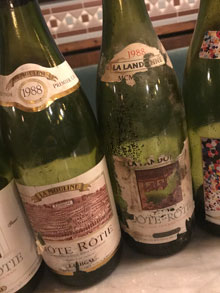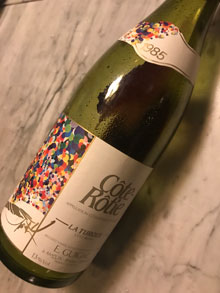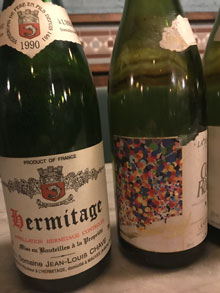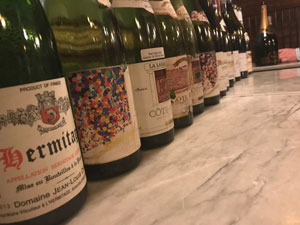Ok, I officially recognize that I am still stuck in March and now three months behind all my notes, and that I never even wrote up the hundreds of Burgundies tasted during our Grande Fete de Bourgogne week back in February. Now that I have addressed my guilty conscience for all these notes I have yet to share, I am addressing another thing that has me feeling guilty – too many of my notes are Burgundy, and I am not sharing enough notes for all the other wine regions. Truth be told, I do drink a lot of everything. Italy is a particular pet peeve, as are the dry GG German Rieslings, Austrian Gruners, and the great value that represents the Rhone, to name a few. But the first place I have to go after Burgundy will always be, of course, Bordeaux.
Bordeaux, Baby
Now before I dive into a most memorable evening of Bordeaux I had last month, I have some unfinished business that first week of March, and a magnificent dinner hosted by Tom Terrific at Quince in San Francisco. It was a Magnum Burgundy dinner, carefully curated by Dapper Dave, with some very special magnums assembled with some of New York and San Francisco’s greatest wine intelligentsia. I guess I do drink a lot of Burgundy, it even has to make its way in my Bordeaux article lol. So here is the lineup and scores, before a brief summary paragraph or two.
| 1. | 1993 Roulot Meursault Charmes | (93M) |
| 2. | 1996 Roulot Meursault Perrieres | (DQ) |
| 3. | 1989 Gagnard-Delagrange Montrachet | (92M) |
| 4. | 1985 Gagnard-Delagrange Montrachet | (95M) |
| 5. | 1990 Ramonet Batard Montrachet | (97M) |
| 6. | 1982 Domaine Leflaive Batard Montrachet | (93M) |
| 7. | 1990 D’Angerville Volnay Clos des Ducs | (93M) |
| 8. | 1990 Ponsot Griottes Chambertin | (92M) |
| 9. | 1990 Ponsot Clos de la Roche VV | (94M) |
| 10. | 1993 Hubert Lignier Clos de la Roche | (DQ) |
| 11. | 1993 Meo-Camuzet Richebourg | (95M) |
| 12. | 1993 Rousseau Chambertin | (99M) |
| 13. | 1991 DRC Grands Echezeaux | (95M) |
| 14. | 1991 DRC Richebourg | (95M) |
| 15. | 1991 DRC La Tache | (96+M) |
| 16. | 1985 Ponsot Clos de la Roche VV | (95M) |
| 17. | 1985 Dujac Bonnes Mares | (98M) |
| 18. | 1985 Rousseau Chambertin | (98M) |
So my first observation of the night was that there is a reason that the prices of Rousseau and Dujac are exploding in the market. The proof was in the bottles of the three most spectacular wines of the night. The 1993 Rousseau is one of the greatest Burgs ever made, as a recent lunch in LA also confirmed. The red fruits, the Asian spices, it wasn’t too rich or too sweet and perfect in each of those regards. It was like an elegant jackhammer.

WOTN
The 1985 Rousseau was close behind it, a bit more yeast with lots of busty red fruit and a granular, granite-like finish. The Dujac was amazing, especially how tight it was, as ’85 is a forward, pleasing year, but this was still not ready despite its beautiful freshness, leather and m۩lange of red and purple fruits. It brought sexy to the party. The only other wine belonging at the top of the pyramid was the 1990 Ramonet. It was lipsmacking and zippy, with milk, corn, spice and mint, and while its fruit was showing some outstanding secondary qualities, its finish was still ascending and primary. It outclassed all the other whites by a few lengths.

Killer 85s
Other than that, while the DRCs were outstanding, they were all a touch dirty and disappointing to some. I had the good fortune of trying three separate bottles of 1991 LT recently at the same occasion, and one of them had that same dirtiness, but not all. Bottle variation is a real thing! The Meo was great but tight, one even calling it ‘repressive.’ It was heavy and deep with lots of animal and natural gases and minerals. I look forward to seeing this evolve over the rest of my life, because that is what it might take! I should also note that a recent bottle of 1993 Lignier Clos de la Roche in NYC was 97 points and spectacular, but this magnum was unfortunately off.

1991 DRCs
Ok, that’s enough about that Burgundy stuff. Let’s talk Bordeaux. On a spring night in New York City, at a restaurant called Daniel, The Big O gathered a few wine hunters together for an epic evening of claret. Well, it wasn’t just any claret, we were talking First Growths, and he first asked us to think about the ’¢óìhouse style.’¢ó He paraphrased Frederic Engerer of Chateau Latour and his views of the Fab Five Firsts. Lafite has the finest tannins, while Latour is more muscular and statuesque in the best vintages, and with enough time the fruit smiles at you. Margaux is the most feminine and floral, while Haut Brion is the most terroir based. Mouton is the most exotic and flamboyant, and those were one very knowledgeable man’s opinions about house styles. Now here’s my opinion about twenty First Growths, fifteen of which were 1961 and older. Let’s go.

Always a Good Sign
We had an ‘acclimation’ wine, a 1978 La Mission Haut Brion. While it lacked the intensity of another recent bottle, it was still a very good wine. Soft, tender and smooth, it was very fresh and ‘delicious.’ Miss Moutai found it quite ‘smoky,’ and an amazing and distinctive Smores like quality developed in the nose with time. However, this particular bottle lacked oomph; another recent bottle was closer to 95 points (92).
The first official wine from our program was a 1989 Haut Brion, not a bad way to start. Although it was served a touch cold, it was as regal as always, so fine, long and elegant. It had a deep ocean of fruit in the mouth, and I saw both the ’59 and ’61 in it, as in the best of both worlds. This was rico suave, and Miss Moutai found (or it) ‘bananas’ (98).

98 X 3
The 1961 Haut Brion had an ‘oh yeah’ nose that was talking out loud with its nutty and creamy style. It had the caramel and the smokehouse with a touch of band-aid along with palm tree and cocoa butter. The cocoa butter really took over, excitingly so. This was a rich, sumptuous, decadent and creamy palate with nice grit, and it was right there with the 1989 qualitatively. Miss Moutai admired its ‘salinity,’ and there was no doubting the quality of the bottle of the glorious 1961 (98).
The 1959 Haut Brion was richer in the nose and more chocolaty. There was a touch of game, but its palate delivered a richer, denser experience than the 1961 with better concentration. There was more plum and chocolate again, and cereal flavors emerged. It had a ‘well formed backbone of acidity’ per one guest, and was ‘coherent and consistent’ per another (98).
Alas, the good luck couldn’t last, and a 1945 Haut Brion was (DQ).
It was Margaux’s turn, starting with a 1982 Margaux, Chateau Margaux lol. There were great grains to its nose, every cereal flavor imaginable. Its mouth was rich and round with a nice kiss of peppermint. There was nice length to this smooth and delicious red, although it was a bit mild. ‘Wet Shitake’ came from Miss Moutai (95).
The 1959 Margaux had lots of black fruits, and more of that reference iron fist. There was more animal here, almost sweat. It was rich and round like the ’82, with nice charcoal flavors on its finish. This was an outstanding wine, a fastball of a Margaux with equal status to the 1982 (95).
The 1945 Margaux was full of old library and old book, much lighter with a more elegant style. This was a pretty wine but a bit of a funky monkey with some windshield wiper in there as well. It was a bit weird at times (91).

Victory Vintage
There was a great nose full of caramel city. It was rich and sexy with loads of toffee candy. While delicious, it quickly lost a step in the glass. Special K noted, ‘blood,’ and someone else admired its smoky and meaty qualities. The wine was a 1928 Margaux (95).
A discussion about the Margaux flight ensued, and the concept of femininity came up, and how that should not be considered equivalent to being weak. Margaux was not feminine like a flower, but rather feminine like a bomb, reasoned one of the women in attendance. I have seen many feminine bombs firsthand, and I agree. I can safely say they are the most deadly lol. Both the HB flight and the Margaux flight had great consistency, and someone observed ‘mint mint mint’ in the Margaux.
Now it was Lafite’s turn, beginning with a 1986 Lafite Rothschild, which was quite elegant. This was more feminine than any Margaux, smooth and soft like satin sheets at first. Its palate had lots of wheaty flavors, and nice concentration emerged with time. This was an outstanding feminine specimen lol (95).
The 1966 Lafite Rothschild was a bit of an outlier given the quality elsewhere, but we marched on. There were curds and whey here with sweet and sour fruit. Special K found it mousy, and it was definitely thinner than anything else so far (90).
It was back to business with a rich and decadent 1959 Lafite Rothschild. My long love affair with this vintage of this wine has been well documented, and my affinity was there all over again with just one whiff. There was this black cherry soda goodness, and the palate was so special, just a step or two behind other memories but still oh so sexy. Cassis, pencil and sweet tannins filled my mouth with glee (97).

Greatest Lafites Ever?
The 1953 Lafite Rothschild has long been a legend of this vintage, along with Margaux. This bottle didn’t disappoint. It was a pinch weedy at first, but it still had this rich toffee decadence. This was a ‘honey bunny’ per one of the guests, and its honeyed sweetness tickled all my senses, too. ‘Pure genius’ was noted by The Big O, as well as the fact that this flight wetted his appetite to the point of salivation, well, at least the last two wines. On this night, and with these two bottles, the ’53 surpassed the ’59 (98).
The next stop on our First Growth train was the 1961 Latour. While the ’61 has always been considered the reference point vintage for this esteemed Chateau, truth be told, more often than not I have preferred the ’59 when head to head. We will get to that soon enough, but first the ’61. It had a deep, dark nose that was wealthy, aka more than rich. Its profile was as black as midnight, and its nose full of heavy cream. There was great tree bark spice here as well, and it was tannic like 1996 to one. While not as thrilling as I wanted it to be at first, it gained in the glass with time and each sip. This was a wine that definitely unfurled (97).

Fantastic Four
The 1959 Latour was richer and frankly better than the 1961. It was another example in my case study. ‘Again ’59 reigns supreme,’ I wrote. Not much more needed to be said, other than black, rich, leathery and zippy. This was a great wine (98).
The 1949 Latour was clearly older than the previous two wines, but there was still outstanding complexity here. There were great old book flavors in this super sexy wine. It was long with a crackling finish, but air took a lot of wind out of the ’49’s sails rather quickly. It got a bit herbal and vegetal thereafter, but it still maintained its outstanding status (95).
The 1929 Latour, the second oldest wine we would have on this evening, had a bit of hot sauce to it. This was buffalo wing city in its nose. It was another rich and sexy wine, adding sumptuous to the mix. There was still grip initially, but a bouillon characteristic soon took over. While the ’61 ascended a couple of points, the ’29 descended accordingly. Cherry cola, barn, hay and mesquite all joined the party. The first sip was 98 point territory (96).
There were four more Firsts to go, the first being a superlative bottle of 1982 Mouton Rothschild. This was so young compared to almost everything else so far, deep and dark like a forest at night. I started to lose sight of my notes, but I saw tobacco and a good quote from The Big O, who could ‘see the future of the wine.’ I didn’t lose sight of my score of this impressive ’82 (98).
There was another very good but lesser ’66, this being the 1966 Mouton Rothschild. It was full of animal, barn and hay, a bit weird. It was Mouton light with ‘peanut butter.’ Another found it to be a good ‘chugger’ (90).
The 1947 Mouton Rothschild was a touch mature and a touch dirty. There was band-aid here as well. This is usually a dead ringer for 1974 Heitz Martha’s, but not on this occasion. I don’t think the bottle was perfect (93A).

Doesn’t Get Much Better
There was one perfect bottle, or as close as it gets, since I don’t believe in perfection. The 1945 Mouton Rothschild once again proved to be one of the greatest wines of all time. The mint, the eucalyptus, the soy, the tea leaves…there was a log going on. Someone found ‘hoisin,’ and without question this was the heaviest and most concentrated wine of the night. This was, indeed, flamboyant, so exotic, practically ‘medieval’ per one. If you wanted to argue that this was the best wine ever made, it would be tough to argue otherwise, although I might have 3-4 recommendations, and they all start with DRC or Petrus (99).
It was great to get back to the Bordeaux basics thanks to The Big O, and it reminded me while Burgundy may be more exciting and enticing for those first thirty years, and while it may be a coin flip for the next twenty, it is tough to argue with the reliability and the ageability of great Bordeaux to go 50-100 years. There isn’t much better, and therein lies its greatness. Cheers to Bordeaux!

So Happy Together
In Vino Veritas,
JK






















